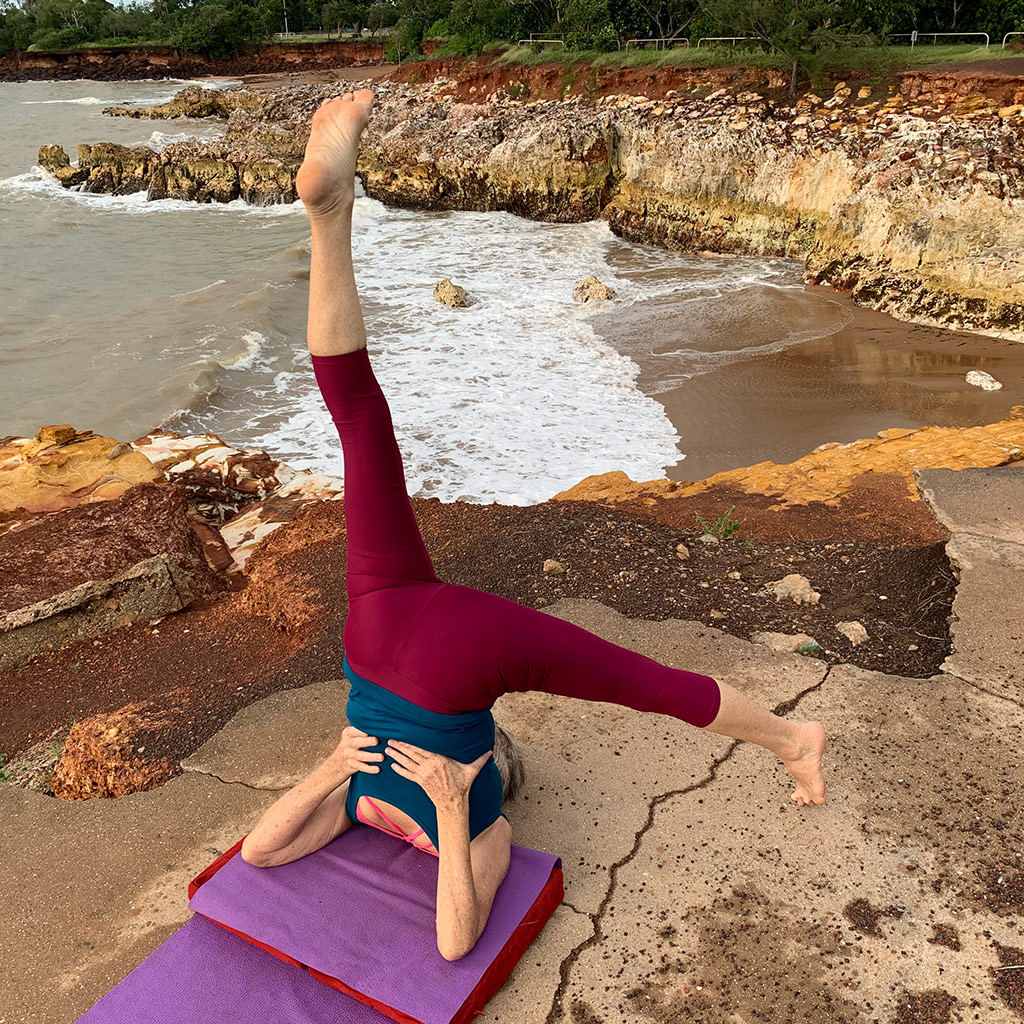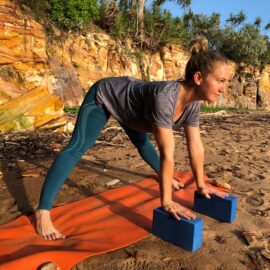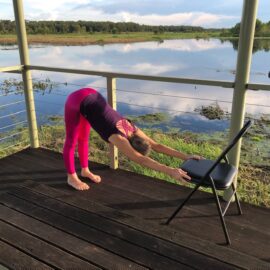Yoga: Connections among immune system, inflammation, fasting, & disease risk
How To Reduce Inflammation In Body Organs: Summary
Dr Merad, a top expert on our immune systems, has found that constant food intake increases inflammation. See the latest research on the deadly role of inflammation. Plus how to reduce inflammation in the body via yoga poses for inflammation.
She talks both about how to reduce inflammation in the body, including the role of snacking. In particular, she talks about the length of the “window” each day during which we consume food (including drinks from which the body extract sugar or other “food”).
She says that when we eat, the immune cells are forced into continual action, to check what we have eaten for “foreign invaders”.
This checking can lead to excess inflammation, which can become dangerous in some cases.
I’m trained to notice inflammation. I see far too much of it. I’ve also worked with my own body, and the yoga practice of many students, to help them use yoga to reduce inflammation in the body.
Dr Merad helped me see why I see so much inflammation about (and how yoga can help reduce it).
In turn, this inflammation increases disease risk, including our risk of COVID19 making us sicker, or worse.
All the patients that Dr Merad studied who had died of COVID19, had not died from excess virus in their organs. She says they died from chronic inflammation in their organs.
I don’t deny the terrible impact of COVID19. Dr Merad’s point is that when people already had chronic inflammation, COVID19 was more likely to be fatal.
Fasting, positivity & mindfulness all help deal with inflammation
Due to her research, Dr Merad took up intermittent fasting. She discovered that fasting INCREASED HER ENERGY LEVELS.
Her research now shows inflammation, and the chance of severe diseases that are related to it, appear to be reduced by intermittent fasting.
I add that studies already show that having a POSITIVE OUTLOOK will also help your immune system work well. Dr Merad also mentions the importance of positivity.
I also know that yoga gives you the MINDFULNESS AND DISCIPLINE to regulate your food intake in a way that reduces inflammation, and get benefits from that.
You’ll find the whole interview with Dr Merad on the podcast called Bulletproof Radio. My longer summary of interview is below.
I stress that people of all sizes and shapes can do yoga very well. Flametree has no view on what you should eat, or when. My focus is on wellness, and how yoga can help in that regard, including by helping you with inflammation issues.
It’s everyone’s very own personal choice as to what their own wellness journey will be.
Try Flametree’s beginner 2-week free trial deal.
Non-beginners can also get 14 days unlimited non-beginner yoga for just $29.
Immune system is our best doctor
“Our immune system is our best doctor” says Dr. Merad.
She is a world expert on our immune systems. She’s doing some of the most up to the moment research on our immune systems, including on COVID patients.
I have been listening to a very recent podcast interview with Dr Merad. The focus of the podcast is on inflammation and how its related to intermittent fasting, cancer and COVID19.
This post is a summary of some key points Dr Merad makes.

Yoga inversions help circulate lymph fluid, & thereby supports your immune system
I listened to the interview because over this last year my study has convinced me that a regular yoga practice can really help support our immune system. I’ll talk about this too.
Constant food intake increases inflammation
Dr. Merad leads the Precision Immunology Institute at the Icahn School of Medicine at Mount Sinai Hospital, New York.
Her research lab recently found that fasting reduces inflammation and improves chronic inflammatory disease outcomes.
Dr Merad set out to understand how the body reacts to different foods, and how the immune system responds to different foods.
She discovered that each time we eat, the bone marrow senses food as threat and releases inflammatory cells to fight the perceived threat.
The immune system, via the bone marrow, is the army of the human body. It’s there to protect us against what we ingest.
If we continually snack, or eat many meals a day, the immune system must work overtime because it believes there is constant threat.
Dr Merad notes in passing that she was a constant snacker, but her research has changed all that!
Dr Merad found that with intermittent fasting, immune cells can go and do their vacuum cleaning work and act as sentinel cells. Then they rest for many hours until food is ingested again.
When we eat more food then we need, or are continually snacking during the day, the immune cells are forced into continual action. This leads to increased and chronic inflammation.
Fasting also increases energy
When Dr Merad undertook to try out intermittent fasting she also discovered to her surprise that her energy levels increased.
Her explanation is that the immune system now gets a chance to return to balance as it does not have to search out and destroy potential foreign invaders that are seen as a threat each time we ingest food.
Dr Merad also mentions studies that show a strong correlation between happiness and immune systems health.
She talks about how important it is to maintain joy in what you eat and every so often break routines.
COVID patients actually die from inflammation
Dr Merad provides insight into the relationship between inflammation and the risk of contracting COVID19.
She notes that we know there are very diverse responses to COVID19. Some people have very few symptoms, some are very tired, others get very ill, and some die.
It is of course early days in our understanding of COVID19. What we currently know is that the big risk factors for becoming infected, and having a severe response to COVID19, are age, diabetes, hypertension, and obesity.
In each of these so-called co-morbidity diseases, there is chronic inflammation. In each of these conditions there has been an exaggerated immune cell response.
All the patients that De Merad studied that had died of COVID19, had not died from excess virus in their organs, but had in fact died from chronic inflammation in their organs.
Diet, yoga and mindfulness implications of Dr Merad’s research
Based on how I know yoga works, here are my take home messages from Dr Merad’s research.
Diet impacts the health of our immune system. The issue is not just what we eat, but the frequency with which we eat.
Because yoga is a practice that promotes self-awareness, and is also a discipline, yoga can help alter what we eat.
The mindfulness that flows form having a yoga practice helps us put in place practices to reduce the frequency that we eat.
I suggest you consider starting with reducing snacks, and then eventually move to having just two meals a day.
Start gradually, such as by first confining your food intake to a 12-hour window. Then successively reduce the window to 10, 8 and finally 6 hours a day.
If you can’t do 6 0r 8 hours, then even 10 hours when you intake food will help. Remember that many of those hours are when you sleep.
Try it. It’s easier than you may think.
I have also found that it becomes easier as you build your yoga practice.
Mindfulness via yoga, can also help with taking more time to chew food and enjoy the flavors of food with each bite.
Obviously, within whatever interval you choose, aim to eat more healthy whole foods, and limit fried junk foods, and foods with high sugar content.
The happiness from yoga also helps your immune system
As Dr Merad says, feeling positive has been shown to help maintain immune health.
It’s well known that exercise improves circulation and produces endorphins. This helps you feel happy and good about yourself.
Being more mindful, as a result of yoga, will also help you connect with your essential self. In a deeper sense, you can enjoy feeling alive.
Among other things, many poses (shoulder stand for example), also help soothe and quieten the nervous system via stimulating the vagus nerve.
The vagus nerve is often referred to as the “love nerve”. When it is stimulated, it allows us to feel compassion for ourselves and others.
In this regard, yoga also helps us see negative thoughts, as well as appreciate that we can learn to practise being grateful each day for what we have.
For at least the last 20 years, research has shown that gratitude is a key factor in positivity and happiness.
Yoga also reminds us to practise kindness towards ourselves and others.
You’ve probably heard of loving kindness meditation. Yoga, and the breath mediation that we teach, gives you the ability to practise a very useful version of it.
Positive thoughts produce a very different outcome in terms of our wellbeing.
At its heart, yoga (and ideally breath meditation as well) offer a holistic approach to health and wellbeing. It recognises that body, breath, mind and emotions are all interconnected.
Our state of physical health, our mind, and our emotional health together impact how well our immune system functions.
Bottom line: Yoga can help with how to reduce inflammation in the body
The bottom line is that this very new research now shows inflammation, and the chance of severe diseases that are related to it, including COVID19, appear to be impacted by intermittent fasting.
Other studies already show that having a positive outlook will also help your immune system work well.
As a yoga student, you have a tool that gives you the mindfulness and discipline to control your food intake, and to get the benefits that flow from it.
You also have other key tools, such as improved ability to relax and think positively, to also help your immune system do its job, and work at how to reduce inflammation in the body.
Still unconvinced about inflammation?
If you look around you, you’ll notice people with an especially ruddy or reddish complexion. That’s often a sign of too much inflammation.
Of course, some people have natural reddish complexions. That’s not what I’m talking about.
I mean that ever growing redness that you often see in pictures of our business or political leaders, many of whom lead an unhealthy, over-indulgent life style.
I also notice it around even my local streets, or at events I go to.
The skin may also be puffy, of blotchy, of a bit shiny, or have all of these unfortunate aspects.
Maybe you may even see it in the mirror! Maybe ask someone close to you if they think you some times have any of these features.
Rather than being ruddy, your skin should just have it’s natural colour.
Starting looking out for the telltale ruddy look, and you’ll see more of it than you might have expected.
More from Flametree Yoga
At any time, Beginners can start via our week-to-week deal, including two weeks free. Most of the poses taught will quickly work to yoga for inflammation in body organs.
The six-week beginner course can also be joined at any beginner class in the two weeks after the course starts. As soon as you get a pass, you can also start unlimited free classes at the beginner level.
NON-BEGINNERS, who are new to Flametree, or lapsed students, get 14 days of unlimited classes for just $29. That’s less than $2 a class for daily non-beginner yoga.
All Flametree packages, including subscription and ten pass deals, are here.




nice work, Chris, thank you.
I wonder at the diabetic level (from my gestational diabetes experience with my first pregnancy in 2006) and the insistence from my health team & medicos that I should eat every 2.5 hours to regulate blood sugar levels and avoid spikes. it is a practice I think about still daily and follow to a degree; the advice was to consume say 1000kj at meals and 500 between and after dinner one serve of yogurt say (for calcium).
The reason I still consider it is because my tendency to have diabetic type 2 symptoms increases if I put on only a few kilos; the nasty lurking possibility of type 2 is a consequence after gestational diabetes. I can also clearly see the link between stress and diabetes, since at the time of that pregnancy and diabetes I was in an abusive relationship, working hard in an office with complex interpersonal dynamic as a skilled professional, with a perspex ceiling for ambitious women. (Glass is too good a material to describe the scratched, more shatter-proof lid, on my profession)
Many of those circumstances no longer exist for me as they did then, life is very good now actually, giving me the ability to see the difference. I can credit the vast improvements in recent years to my regular yoga practice and the flame tree great mentoring, combined with occasional mentioning of the yoga texts by Iyengar, of which I purchased 4 and began reading and enjoying in 2019.
HI Joanna. On behalf of Flametree, thank you for sharing your experience of yoga, and more. Very glad to hear it has helped.